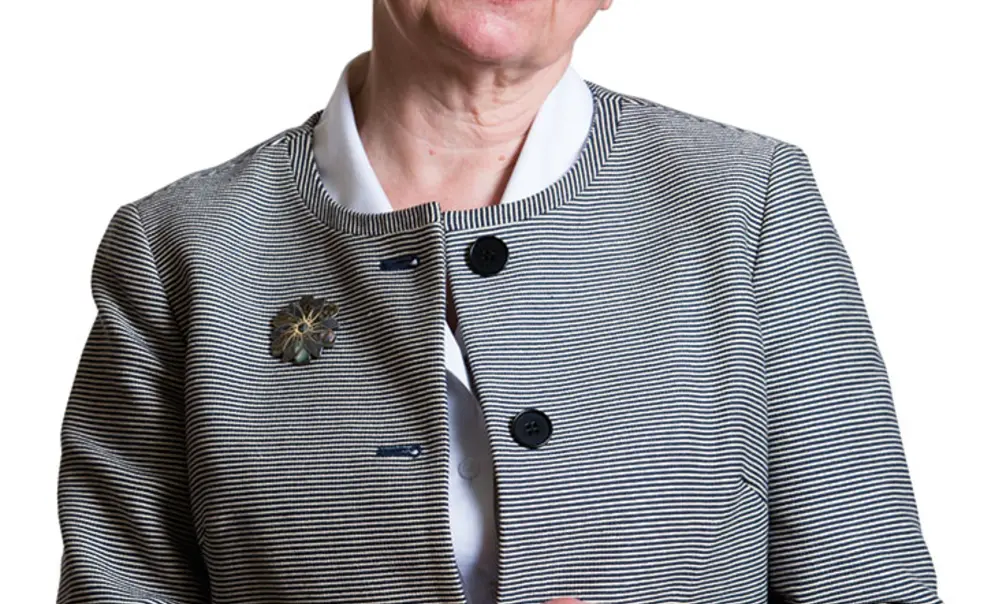Q&A: Karin Trainer: ‘Print Is Not Dead’
As Firestone renovations proceed, librarian Trainer prepares to retire
Six stories above ground, University Librarian Karin Trainer shows off her favorite spot in the sprawling library system: the newly renovated tower of Firestone Library, where bountiful natural light streams from high windows offering far-ranging views across campus. The tower’s transformation from storage space to study space, amid Firestone’s 10-year, $250 million renovation, is one tangible result of Trainer’s 20-year tenure, which will end with her Oct. 1 retirement.
“People have asked me why I stayed in this job for 20 years, and the reality is I’ve just loved it too much to quit,” Trainer says. But at 67, she adds, it was time to make way for someone new. PAW spoke with Trainer in May about the work she’s done and the challenges facing her successor, Anne Jarvis, who currently heads the University of Cambridge library.
You started your career at Firestone.
At the end of 1972, I was hired as a cataloger. I wanted to become a cataloger because a cataloger got to handle all of the brand-new books as soon as they got unpacked in the shipping room. All of these lovely new books with their shiny bright covers would be put on a truck, and it was up to the catalogers to get them ready to go on the shelf. That was my idea of what I was going to do with my life.
The idea that a woman would ever be the University librarian — that was impossible. Even though librarianship is a women’s profession, the most senior management jobs were traditionally only for men, and women were the handmaidens of these operations. But I was lucky, and this changed fairly quickly.
What is Princeton’s relationship with other university research libraries?
When I started at Princeton in 1996, we were more competitive — in a friendly way, but more competitive than collaborative. You got prestige by being able to demonstrate that you stood on your own. But that’s not the case anymore. We’re increasingly finding ways to collaborate, to build collections in a shared way. In a world where the amount of publication continues to increase dramatically, none of us can pretend that we can cover the entire world of important research material. We’re going to need to do even more along those lines, particularly as it comes to figuring out how to capture and preserve different kinds of digital content that are likely to be the foundations for research in the future. Princeton is not going to solve that problem by itself.
Is print dead?
Print is definitely not dead. We’re still acquiring more than a mile’s worth of new publications every year. It’s true that students do not check out as many books as they used to, but they still check out a lot of books.
How much of a problem is the rising expense of scholarly journals, which now cost Princeton $9 million a year — more than a third of the acquisitions budget?
It’s a very serious problem for us and for all research libraries. It’s a real balancing act. We’re committed to preventing the cost of journals from overwhelming our ability to acquire books and special collections and other kinds of research material.
Why leave before 2018, when the Firestone renovation will conclude?
The project is so well along and is overseen by such an extraordinarily capable group of architects and library staff members that I know it’s going to be finished on time, and it’s going to be a big success. I can already see the results. The use of Firestone has shot up — in the first three months of this semester, we had more than 160,000 people come into this building. That’s certainly well more than double when I came.
What challenges face your successor?
Creating a new generation of Princeton librarians is one of them. We have a large cadre of baby-boomer librarians. They have decades of knowledge about whatever specialty they’re in, and they have begun to retire. The challenges include figuring out what additional steps we need to create digital versions of the printed collections: How are we going to do that; how are we going to pay for it? It’s also time for a new system to help users find material that we own or license. We need a powerful system that plucks from a gigantic mass of information exactly the things that will help a user out. That’s a lot harder than it sounds.
What are your retirement plans?
I plan to catch up on reading all of these millions of books we’ve acquired. My idea is still that book truck with all of those lovely, brand-new shiny books on it.
Interview conducted and condensed by Deborah Yaffe












No responses yet